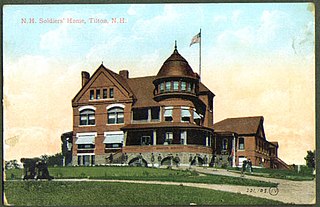
An old soldiers' home is a military veterans' retirement home, nursing home, or hospital, or sometimes even an institution for the care of the widows and orphans of a nation's soldiers, sailors, and marines, etc.
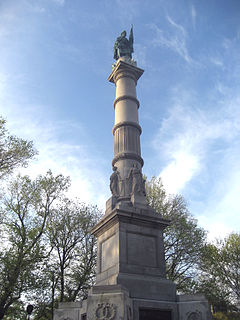
The Soldiers and Sailors Monument on Boston Common at Boston, in the U.S. Commonwealth of Massachusetts, was erected in memory of Massachusetts soldiers and sailors who died in the American Civil War. Designed by Martin Milmore, construction began in 1874 and the monument was dedicated on September 17, 1877. Union Generals George B. McClellan and Joseph Hooker were among the estimated 25,000 people attending the dedication on Boston Common.

Caspar Buberl was an American sculptor. He is best known for his Civil War monuments, for the terra cotta relief panels on the Garfield Memorial in Cleveland, Ohio, and for the 1,200-foot (370 m)-long frieze on the Pension Building in Washington, D.C..

Philadelphia National Cemetery is a United States national cemetery located in Philadelphia, Pennsylvania, north of Germantown. It is administered by the United States Department of Veterans Affairs, and managed by the National Cemetery Administration from offices at Washington Crossing National Cemetery.
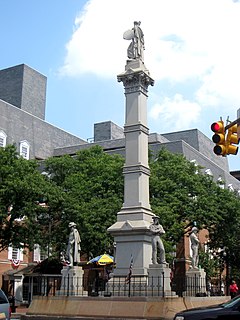
The Soldiers and Sailors Monument is a 43-foot (13 m) tall Gothic Revival memorial which stands in Penn Square in downtown Lancaster, Pennsylvania. It was dedicated on July 4, 1874, at its present site on the Northeast intersection of King and Queen Streets. The monument's original intention was to pay tribute to Lancastrian Union soldiers killed during the American Civil War. However, today the Soldiers and Sailors Monument also represents those who have served in subsequent American military conflicts.

Memorial gates and arches are architectural monuments in the form of gates and arches or other entrances, constructed as a memorial, often dedicated to a particular war though some are dedicated to individuals. The function is similar to that of a triumphal arch, with the emphasis on remembrance and commemoration, rather than celebration and victory, though some memorial arches perform both functions. They can vary in size, but are commonly monumental stone structures combining features of both an archway and a gate, often forming an entrance or straddling a roadway, but sometimes constructed in isolation as a standalone structure, or on a smaller scale as a local memorial to war dead. Although they can share architectural features with triumphal arches, memorial arches and gates constructed from the 20th century onwards often have the names of the dead inscribed on them as an act of commemoration.
Soldier's Monument may refer to any of the Soldiers' and Sailors' Monuments or to:
Frederick Cleveland Hibbard Chicago based American sculptor, born in Canton, Missouri. He graduated from the University of Missouri before deciding to be a sculptor and becoming a pupil of Lorado Taft's at the School of the Art Institute of Chicago. Hibbard is best remembered for his Civil War memorials, produced to commemorate both the Union and Confederate causes.

Libby Hill is a small neighborhood in Richmond, Virginia. Libby Hill is located on the southeastern spur of Church Hill, overlooking the James River and the Lucky Strike building. It is known for Libby Hill Park and "The View that Named Richmond". The Libby Hill neighborhood is entirely within the St. John's Church Historic District.

The Confederate Soldiers and Sailors Monument was a monument in Baltimore, Maryland, installed in 1903 and removed in 2017.

The Confederate Soldiers and Sailors Monument is a large granite monument that sits at the south entrance of Garfield Park in Indianapolis to commemorate the Confederate prisoners of war that died at Camp Morton. At 35 feet (11 m) tall and located in the city's oldest public park, it is the most prominent of the very few Confederate memorials in the Union state of Indiana.
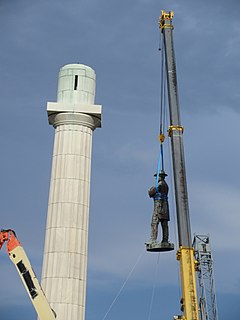
For decades in the U.S., there have been isolated incidents of removal of Confederate monuments and memorials, although generally opposed in public opinion polls, and several U.S. states have passed laws to hinder or prohibit further removals.
The Confederate Soldiers and Sailors Monument is a commemorative obelisk that was erected in Linn Park, Birmingham, Alabama in 1905. The monument was dismantled and removed in 2020.
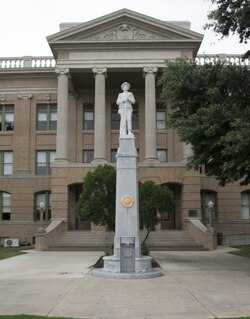
The Confederate Soldiers and Sailors Monument is an outdoor Confederate memorial installed outside the Williamson County Courthouse in Georgetown, Texas, United States.

Linn Park is a seven-acre (2.8 ha) urban park in the centre of Birmingham, Alabama. It is overlooked by Birmingham City Hall. Formerly known as Capitol Park, Woodrow Wilson Park, and Central Park, the park was renamed after Confederate naval officer and businessman Charles Linn in the 1980s.
During the protests and riots that followed the May, 2020, death of George Floyd, a number of Confederate monuments and memorials were removed, or plans to remove them were announced. In addition, the statue of Philadelphia police chief and mayor Frank Rizzo was removed at 2 am on June 3, 2020.
A statue of Charles Linn was previously installed in Birmingham, Alabama's Linn Park, in the United States. The statue was installed in 2013 and toppled in 2020.











